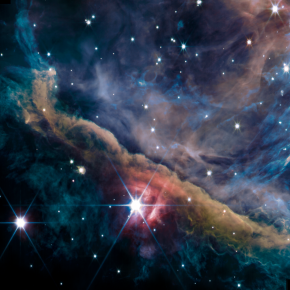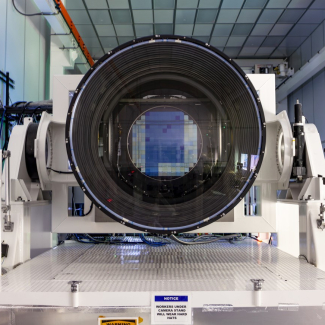
The James Webb telescope: first images of the Orion Nebula
|
|
An international research team has released the first images of the Orion Nebula, the closest richly productive stellar nursery to our own solar system. Captured by the James Webb Space Telescope, these pictures demonstrate once again the exceptional capacities of this scientific instrument. Headed jointly by researchers from CNRS, Université Paris-Saclay and the University of Western Ontario in Canada, the observations also involved astronomers from the Observatoire de Paris-PSL, with the backing of the CNES (French National Centre for Space Studies).
To feast our eyes on the birthplace of stars… It’s now possible thanks to the work of the researchers who recently used the James Webb Space Telescope to capture new images, the clearest and most detailed ever taken of the inner region of the Orion Nebula. The observations were made possible by, and confirm, the revolutionary capacities of the Webb instrument.
Located in the Orion constellation, 1,350 light-years from Earth, the Orion Nebula is a matter-rich zone in which many stars are formed. The environment seems to be similar to the one in which our solar system was born more than 4.5 billion years ago, and studying it will improve our understanding of the prevailing conditions of that time.
The core of stellar nurseries like the Orion Nebula is obscured by enormous quantities of dust, making it impossible to observe them using visible light via telescopes like the Hubble. The James Webb Space Telescope observes the infrared light of the cosmos, making it possible to see through these layers of dust and lifting the veil at last on what takes place deep inside the nebula.
First of all, it reveals many spectacular structures, down to scales of approximately 40 AU1 . Among them, a number of dense filaments that could be conducive to the birth of a new generation of stars have been observed, as well as stellar systems in formation. The latter consist of a central protostar surrounded by a disk of dust and gas within which planets are formed.
The Orion Nebula also contains a cluster of young massive stars called the Trapezium Cluster, which emits intense ultraviolet radiation, capable of shaping the clouds of dust and gas. How this phenomenon affects the environment is a key question for studying the formation of stellar systems like our own solar system.
These findings are the fruit of one of the James Webb telescope’s priority observation programmes, mobilising some 100 researchers in 18 countries2 and jointly headed by scientists from CNRS, Université Paris-Saclay and the University of Western Ontario in London, Ontario, Canada. The programmes were selected following an international call for proposals for the James Webb Space Telescope.
The research team is analysing the data gathered on the Orion Nebula, and promises new discoveries on the earliest phases in the formation of stellar and planetary systems.

This is a composite image from several filters showing the infrared radiation of ionised gas, hydrocarbons, molecular gas, dust and scattered starlight. The Orion Bar, a dense wall of gas and dust extending from the upper left to the lower right of the image, contains the most visible bright star, θ2 Orionis A. The view is illuminated by a cluster of hot young massive stars called the Trapezium Cluster, seen here at the far top right of the image. The cluster’s powerful, intense ultraviolet radiation creates a hot ionised environment in the upper right section, which is slowly eroding the Orion Bar. The molecules and dust can survive longer in the dense shielded environment offered by the Orion Bar, but the energy from the stars carves out a region that displays an incredible wealth of filaments, globules, young stars with disks and cavities.
© NASA/ESA/CSA/PDRs4All ERS Team/Salomé Fuenmayor
This image was obtained with the NIRCam instrument of the James Webb Space Telescope on September 11, 2022. Several images from different filters were combined to create this composite image: F140M and F210M (blue); F277W, F300M, F323N, F335M and F332W (green); F405N (orange); and F444W, F480M and F470N (red).

Filaments: the entire image is rich in filaments of different sizes and shapes. The inset here shows thin sinuous filaments that are especially rich in hydrocarbon molecules and molecular hydrogen. They are believed to have been created by the turbulent movements of gas within the nebula.
θ2 Orionis A: the brightest star in this image is θ2 Orionis A, which is just bright enough to be discerned by the naked eye from a dark place on Earth. The red glow immediately around it is caused by stellar light reflecting off dust particles.
A young star within a globule: when dense clouds of gas and dust become unstable, they collapse into stellar embryos that gradually grow more massive until they can start nuclear fusion in their core, causing them to shine. This young star is still embedded in its natal cloud.
© NASA/ESA/CSA/PDRs4All ERS Team/Salomé Fuenmayor

© NASA/ESA/CSA/PDRs4All ERS Team/Salomé Fuenmayor/Olivier Berné
More images can be seen here.
- 1For Astronomical Unit. One AU corresponds approximatively to the distance between Earth and the sun. 10 AU corresponds to the distance between Saturn and the sun.
- 2In France, the research involved scientists from the IRAP (Institut de Recherche en Astrophysique et Planétologie, Research Institute in Astrophysics and Planetology, CNRS/CNES/UT3 Paul Sabatier), the IAS (Institut d’Astrophysique Spatiale, Institute of Spatial Astrophysics, CNRS/Université Paris-Saclay), the LERMA (Laboratoire d’Études du Rayonnement et de la Matière en Astrophysique et Atmosphères, Laboratory for Radiation and Matter Studies in Astrophysics and Atmospheres, Observatoire de Paris – PSL/CNRS/Sorbonne Université/Université de Cergy-Pontoise), the ISMO (Institut des Sciences Moléculaires d’Orsay, Orsay Institute of Molecular Sciences, CNRS/Université Paris-Saclay), the IPAG (Institut de Planétologie et d’Astrophysique de Grenoble, Institute for Planetary Sciences and Astrophysics, Grenoble, CNRS/UGA), the Physics Laboratory of the École Normale Supérieure (CNRS/ENS-PSL/Sorbonne Université/Université Paris Cité), the IJCLab (Laboratoire de Physique des Deux Infinis Irène Joliot-Curie, Irène Joliot-Curie Laboratory of Physics of the Two Infinities, CNRS/Université Paris Saclay), the IPR (Institut de Physique de Rennes, Institute of Physics of Rennes, CNRS/Université de Rennes 1), the IAP (Institut d'Astrophysique de Paris, Paris Astrophysics Institute, CNRS/Sorbonne Université), the LAIM (Laboratoire Astrophysique, Instrumentation, Modélisation; Astrophysics, Instrumentation and Modelling Laboratory, CNRS/CEA/Université Paris Cité), the ISM (Institut des Sciences Moléculaires, Molecular Sciences Institute, CNRS/Institut Polytechnique de Bordeaux/Université de Bordeaux), and the LCPQ (Laboratoire de Chimie et Physique Quantiques, Laboratory of Quantum Chemistry and Physics, CNRS/UT3 Paul Sabatier).


